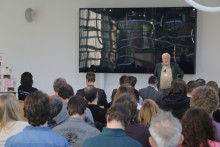The Lustrum conference was organized by W.T.S. Ideefiks, a study association for the master Philosophy of Science, Technology and Society (PSTS) at the University of Twente. This year’s edition also welcomed one of the pioneers of the philosophy of science and technology, Prof. Don Ihde. His lecture was titled ‘From Lions and Tigers and Bears to Drones and Robots and Screens’.
Robots riding camels
Don Ihde talked mostly about what he calls ‘sexy technologies’ or, in other words, technologies that are not necessarily the most important but perhaps the most interesting. Robots are certainly one great example. ‘Robots have the power to cause cultural transformation’, says Ihde. ‘Let’s take camel racing in Arabic countries, for instance. Very young boys of 18 months were used as camel jockeys. This was very dangerous and had negative effects on the children. But then technology stepped in and now people use radio controlled robots with little whips and turbans instead of human jockeys. That is a big cultural change.’
Culturally specific robots
Not only can robots form cultures, they are also formed by cultures themselves. ‘There are big cultural differences in making robots between Japan and the USA, for example. Japanese robot makers tend to create anthropomorphized robots. Most American robots, on the other hand, don’t look human at all; they are very machinelike. That relates to different religious backgrounds. In the U.S. people see a big difference between people and animals and animate and inanimate things’, says Ihde.
Screen addiction
Another example of a technology that practically changed the world is a screen, claims Ihde: ‘It is astonishing to see what happened to the human race since the invention of screens. I would even call it screen addiction.’ Indeed, most inventions that we can’t imagine our lives without involving screens – let´s mention computers, TV or phones. Almost every single person on the planet has access to cell phones that connect us to the rest of the universe. And it is the imaging technologies that allowed us to explore the universe in the first place. In less than one hundred years we discovered millions of new galaxies.
Technologies of the future
Robots and screens – those would be the most important technologies of today. But what about tomorrow? According to Don Ihde, people should surely use more solar cells to help solve environmental problems. He also sees a great potential in 3D printers that could be used for printing substitutes for parts of a human body and in femto-photography, a technique which – by taking a trillion frames per second - essentially allows us to see the invisible.








